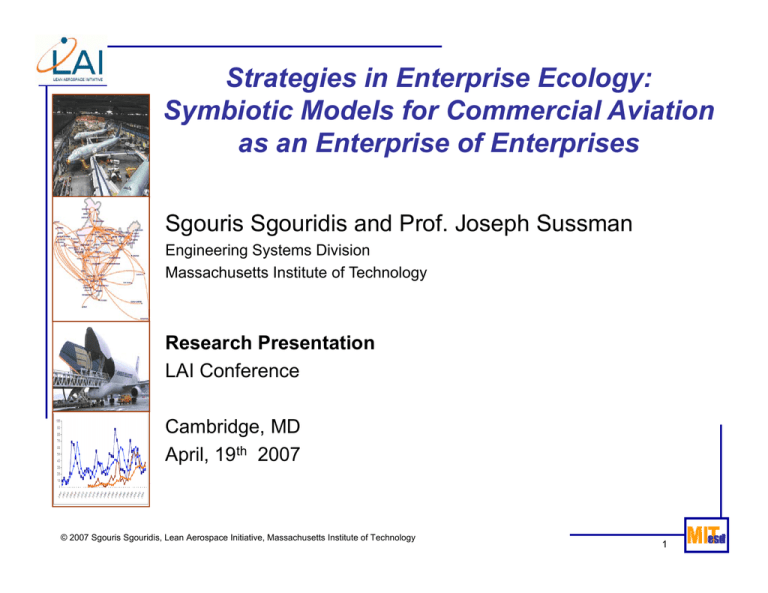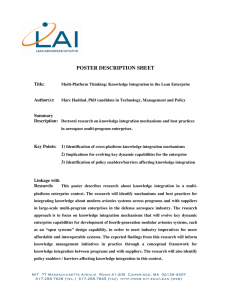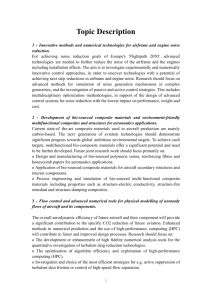Strategies in Enterprise Ecology: Symbiotic Models for Commercial Aviation
advertisement

Strategies in Enterprise Ecology: Symbiotic Models for Commercial Aviation as an Enterprise of Enterprises Sgouris Sgouridis and Prof. Joseph Sussman Engineering Systems Division Massachusetts Institute of Technology Research Presentation LAI Conference Cambridge, MD April, 19th 2007 © 2007 Sgouris Sgouridis, Lean Aerospace Initiative, Massachusetts Institute of Technology 1 Agenda • Hypotheses • Background – Commercial Aviation Cycles – Enterprises and business cycles • A fframework: k Enterprise E t i off Enterprises E t i • Modeling g Enterprise p of Enterprises p • Countercyclical strategies and symbiosis bi i © 2007 Sgouris Sgouridis, Lean Aerospace Initiative, Massachusetts Institute of Technology 2 Hypotheses • • • Cyclical instability characterizes the Commercial Aviation EoE. Cyclicality is costly to the industries involved and society. There are feasible strategies that can dampen the cycles in a long long-term term Pareto efficient manner. © 2007 Sgouris Sgouridis, Lean Aerospace Initiative, Massachusetts Institute of Technology 3 Business Cycles? World Airlines Operating Results and Orders 7,000.00 900 700 5,000.00 500 3 000 00 3,000.00 300 1,000.00 2004 2002 2000 1998 1996 1994 1992 1990 1988 1986 1984 1982 1980 1978 1976 1974 1972 1970 1968 1966 1964 1962 1960 -1,000.00 100 -100 -300 3 000 00 -3,000.00 Airline operating results -500 Narrow body orders -5,000.00 -7,000.00 Widebody orders -700 -900 Shipbuilding in tons for Norwegian Ship Owners (1883-1913) [Source: Einarsen 1938] © 2007 Sgouris Sgouridis, Lean Aerospace Initiative, Massachusetts Institute of Technology 4 0 0.00 -1,000 -1,000.00 1975 © 2007 Sgouris Sgouridis, Lean Aerospace Initiative, Massachusetts Institute of Technology 1,000 -2,000 -2,000.00 -3,000.00 -3,000 -4,000.00 4,000.00 4 000 -4,000 -5,000.00 -5,000 -6,000.00 -6,000 5 2005 1,000.00 2005 2,000 2004 2,000.00 2004 3,000.00 2003 4,000.00 2003 2002 2002 2001 2001 2000 2000 1999 1999 1998 1998 1997 1997 1996 1996 1995 1995 1994 1994 1993 1993 1992 1992 1991 1991 1990 1990 1989 1989 1988 1988 1987 1987 1986 1986 1985 1985 1984 1984 1983 1983 1982 1982 1981 1981 1980 1980 1979 1979 1978 1978 1977 1977 1976 1976 4,000 300 Seat Deliveries NetProfit 300000 3,000 Seat Orders Seat Orders 250 Narrow Delivered Wide Delivered 200 250000 0 0 -50 Thousands 2004 2002 19 999 2000 19 998 19 997 1998 19 995 1996 19 996 19 993 1994 19 994 19 991 1992 19 992 19 989 1990 19 990 19 987 1988 19 988 19 985 1986 19 986 19 983 1984 19 984 19 981 1982 19 982 19 979 1980 19 980 19 977 1978 19 978 19 975 1976 19 976 19 973 1974 19 974 19 971 1972 19 972 1970 19 970 19 969 1968 19 968 19 967 19 966 1966 19 965 19 964 1964 19 963 19 962 1962 19 960 1960 19 961 35% 4,000 30% 3,500 25% 3,000 1975 1974 1974 1973 1973 1972 1972 1971 1971 1970 1970 1969 1969 1968 1968 1967 1967 1966 1966 1965 1965 1964 1964 1963 1963 1962 1962 1961 1961 1,000 5% 500 0% 0 -5% 1960 1960 Commercial Aviation Cyclicality (hi)Story Global Demand for Air Travel in Billion RPKs demand in RPK global gdp Poly. (demand in RPK) 20% 2,500 2,000 2 000 15% 1,500 10% NetProfit 200000 150000 150 100000 100 50 50000 E Endogenou us T Triggers Enabling Factors for Cyclicality in CA Disruptive technologies Jets, 2-pilot cockpit, fuel efficient designs, product families etc. Technical regulations Noise abatement, stage 2,3,4 aircraft Input shocks Fuel prices, materials, interest rates Demand shocks Iraq war I, 9/11, SARS etc. Reinvestment cycle Intertemporal substitution Aircraft as large capital investment with limited but adjustable lifetime Bullwhip in supply chains, labor, and inventory Long lead times for both labor and capital.Irreversibility Industry characteristics Scale economies and large g investment in upfront p R&D incentivize airframe mfg. to promote their wares aggressively in short term Low marginal costs for airlines Market regulations Deregulation combined with imperfect financing allows multiple entrants. Subsidies, bankruptcy protections, and national pride policies retain players in weak markets Decision-making Bounded rationality and strategic optimism create overreaction by multiple entrants. Large number of decision makers. Financing volatility Debt and equity financing available in economic upturns lowers barriers to entry BUT dries quickly in downturns increasing risk of price wars. Short-term returns can be overemphasized over long-term stability. © 2007 Sgouris Sgouridis, Lean Aerospace Initiative, Massachusetts Institute of Technology 6 Framework: the Commercial Aviation Enterprise of Enterprises Return ent Investme Capital Markets Revenue e Aircraftt Flexibilitty Passengers and Shippers Demand Revenue Safety Regulations Labor Subsidies Orders Revenue Fare Capacity Airlines Airlines Airlines Defense Stability Revenue Subsidies Spillovers Labor Spillovers Suppliers pp Price Aircraft qualities Airframe Integrators Labor Defense Modules R&D Aircraftt Revenue e Leasing Companies Economic Activity Government © 2007 Sgouris Sgouridis, Lean Aerospace Initiative, Massachusetts Institute of Technology 7 Narrowbody y division + SDM CA EoE Demand Forecast Revenues + Airframe Airline industry + + Profits - g A Mfg. Demand ? + + Capacity Additions + Expenses Price + + Demand Narrowbody Capacity Utilization Current Capacity - + + Widebody division Demand Forecast Revenues + + + Profits Economic and - Demand ? + + Expenses Price + + Capacity Utilization Narrowbody division + + Capacity Additions - Current Capacity external factors + Widebody Demand Forecast Revenues + + + Profits - Airframe Demand ? Price + + Mfg. B + + + Capacity Additions + Expenses Revenues + + C Capacity it Utilization - Current Capacity - + + Expenses + Widebody division Price + • • • Based on H.B. Weil’s airline industry model (1996) Developed further in collaboration with Jijun and Josh. Using Anylogic Profits + - Demand Demand Forecast ? Capacity Utilization © 2007 Sgouris Sgouridis, Lean Aerospace Initiative, Massachusetts Institute of Technology + + Orders - Current Capacity + 8 SDM Calibration: Demand and Capacity Period: 1984-2025 Green: Observed (until 2005, Data source: ATA) Red: Simulated © 2007 Sgouris Sgouridis, Lean Aerospace Initiative, Massachusetts Institute of Technology 9 Strategy Experiments 1. Identify value functions of stakeholders 2. Quantify and weight value functions. Formulate as mutliobjective optimization 3. Identify strategic alternatives 4. Identify future scenarios and strategic bundles to establish parameter values 5. Execute the model by varying the strategic bundles (inputs) across scenarios 6. Compare the results and select the strategic bundles with robust performance 7. Qualitatively study the implementability of each bundle © 2007 Sgouris Sgouridis, Lean Aerospace Initiative, Massachusetts Institute of Technology 10 1. Value propositions and Metrics Stakeholder Passenger/ Shi Shipper Carriers Airframe Mfgs. Capital markets Governments Values Availability of air travel Affordability of air travel Service of air travel Economic/investment return Stability of return Minimum time in recession Metrics Average ASK/year Undiscounted average fare Frequency, amenities (load factors as proxy) Economic Value Added (EVA: Op. Profit – Taxes – Cost of Capital) Discounted to NPV Standard deviation from trend Average time with return less than target Same as carriers Combination of carriers and airframe manufacturers returns maximized and stable Availability of air travel Returns of domestic champions Metrics above Metrics above Metrics above © 2007 Sgouris Sgouridis, Lean Aerospace Initiative, Massachusetts Institute of Technology 11 2. Value Functions in the CA EoE as Multiobjective j Optimization* p Stakeholder Passenger/ Shipper Carriers Airframe Mfgs. Capital p markets Governments Values A il bilit off airi ttravell Availability Affordability of air travel Service of air travel Economic/investment return Stability of return Minimum time in recession Combination of carriers and airframe manufacturers returns maximized and stable Availability of air travel Returns of domestic champions * Anylogic y og c & OptQuest use tabu search algorithms to perform the optimization © 2007 Sgouris Sgouridis, Lean Aerospace Initiative, Massachusetts Institute of Technology 12 3. Airline Potential Strategic Areas Strategic Area Desired effect Leasing Flexibility. Reduces fixed capacity costs. Profit-sharing programs Flexibility. Reduces labor costs during hard times. Good mix of ages in the fleet Flexibility. Old amortized aircraft can be retired or parked without penalty on fixed costs. Off-cyclical Off cyclical behavior (buy low, sell high) Bullwhip reduction reduction. Individual airline bottom line boost. boost Steady ordering and flexible retirement Bullwhip reduction. Long-term profit-based planning Bullwhip reduction. Compared to short-term profit-based vs. marketshare based planning. Less aggressive revenue managementt Bullwhip reduction. Marginal costs of seats are not zero – holding off price i wars. Mergers Number of players. Consolidating capacity will increase market power and reduce excessive capacity. Tempered expectations Decision making. making Reducing irrational exuberance. exuberance © 2007 Sgouris Sgouridis, Lean Aerospace Initiative, Massachusetts Institute of Technology 13 3. Airframe Manufacturers Strategic Areas Strategic Area Desired Effect Pricing Bullwhip reduction. Pro-cyclical pricing vs. stable pricing. Need based delivery: Auctioning production slots. Ordering Flexibility. Allowing family orders with specification of size later in time. Flexibility time Order cancellation policies Order vetting. Standardize aircraft.design Flexibility. Stronger second hand and leasing markets. Facilitate quick post-manufacture customization (custom color schemes). schemes) Fly-by-the-hour aircraft services. Transformation from aircraft manufacturer to service provider: Fly-by-the-hour aircraft services. New aircraft family release l titiming. i Cycle dampening. Follow the reinvestment cycle. Production capacity management. Cycle dampening. Allow backlogs to build before new production facility is established. Capacity delivery lead times. Bullwhip reduction. reduction Capacity effects are felt faster. faster Capacity inflow is more stable. Flexible production. Production and development costs (lean improvements) Bullwhip reduction. Lower capacity costs and higher profit margins. © 2007 Sgouris Sgouridis, Lean Aerospace Initiative, Massachusetts Institute of Technology 14 Next Steps • Formulate experiments (DOE) • Run experiments • Draw conclusions and consider the implementability of the bundles of strategic alternatives © 2007 Sgouris Sgouridis, Lean Aerospace Initiative, Massachusetts Institute of Technology 15




